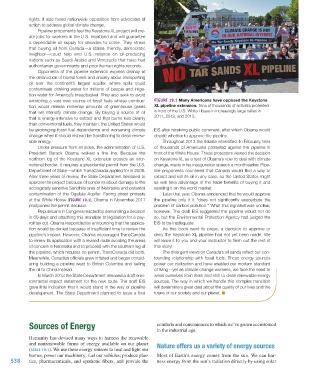Page 539 - Environment: The Science Behind the Stories
P. 539
rights. It also faced nationwide opposition from advocates of
action to address global climate change.
Pipeline proponents feel the Keystone XL project will cre-
ate jobs for workers in the U.S. heartland and will guarantee
a dependable oil supply for decades to come. They stress
that buying oil from Canada—a stable, friendly, democratic
neighbor—could help end U.S. reliance on oil-producing
nations such as Saudi Arabia and Venezuela that have had
authoritarian governments and poor human rights records.
Opponents of the pipeline extension express dismay at
the destruction of boreal forest and anxiety about transporting
oil over the continent’s largest aquifer, where spills could
contaminate drinking water for millions of people and irriga-
tion water for America’s breadbasket. They also seek to avoid
extracting a vast new source of fossil fuels whose combus- FIGURE 19.1 Many Americans have opposed the Keystone
tion would release immense amounts of greenhouse gases XL pipeline extension. Tens of thousands of activists protested
that will intensify climate change. By buying a source of oil in front of the U.S. White House in increasingly large rallies in
that is energy-intensive to extract and that burns less cleanly 2011, 2012, and 2013.
than conventional fuels, they maintain, the United States would
be prolonging fossil fuel dependence and worsening climate EIS after receiving public comment, after which Obama would
change when it should instead be transitioning to clean renew- decide whether to approve the pipeline.
able energy. Throughout 2013 the debate intensified. In February, tens
Under pressure from all sides, the administration of U.S. of thousands of Americans protested against the pipeline in
President Barack Obama walked a fine line. Because the front of the White House. These protestors viewed the decision
northern leg of the Keystone XL extension crosses an inter- on Keystone XL as a test of Obama’s vow to deal with climate
national border, it requires a presidential permit from the U.S. change, made in his inauguration speech a month earlier. Pipe-
Department of State—which TransCanada applied for in 2008. line proponents countered that Canada would find a way to
After three years of review, the State Department hesitated to extract and sell its oil in any case, so the United States might
approve the project because of concerns about damage to the as well take advantage of the trade benefits of buying it and
ecologically sensitive Sandhills area of Nebraska and potential reselling it on the world market.
contamination of the Ogallala Aquifer. Facing street protests Later that year, Obama announced that he would approve
at the White House (FIGURE 19.1), Obama in November 2011 the pipeline only if it “does not significantly exacerbate the
postponed the permit decision. problem of carbon pollution.” What this signaled was unclear,
Republicans in Congress reacted by demanding a decision however: The draft EIS suggested the pipeline would not do
in 60 days and attaching this mandate to legislation for a pay- so, but the Environmental Protection Agency had judged the
roll tax cut. Obama responded by announcing that the applica- EIS to be inadequate.
tion would be denied because of insufficient time to review the As this book went to press, a decision to approve or
pipeline’s impact. However, Obama encouraged TransCanada deny the Keystone XL pipeline had not yet been made. We
to renew its application with a revised route avoiding the areas will leave it to you and your instructor to flesh out the rest of
of concern in Nebraska and to proceed with the southern leg of this story!
the pipeline, which requires no permit. TransCanada did both. The divergent views on Canada’s oil sands reflect our con-
Meanwhile, Canadian officials grew irritated and began consid- founding relationship with fossil fuels. These energy sources
ering building a pipeline west to British Columbia and selling power our civilization and have enabled our modern standard
the oil to China instead. of living—yet as climate change worsens, we face the need to
In March 2013 the State Department released a draft envi- wean ourselves from them and shift to clean renewable energy
ronmental impact statement for the new route. The draft EIS sources. The way in which we handle this complex transition
gave little indication that it would stand in the way of pipeline will determine a great deal about the quality of our lives and the
development. The State Department planned to issue a final future of our society and our planet.
Sources of Energy comforts and conveniences to which we’ve grown accustomed
in the industrial age.
Humanity has devised many ways to harness the renewable
and nonrenewable forms of energy available on our planet Nature offers us a variety of energy sources
(TABLE 19.1). We use these energy sources to heat and light our
homes; power our machinery; fuel our vehicles; produce plas- Most of Earth’s energy comes from the sun. We can har-
538 tics, pharmaceuticals, and synthetic fibers; and provide the ness energy from the sun’s radiation directly by using solar
M19_WITH7428_05_SE_C19.indd 538 12/12/14 5:22 PM

